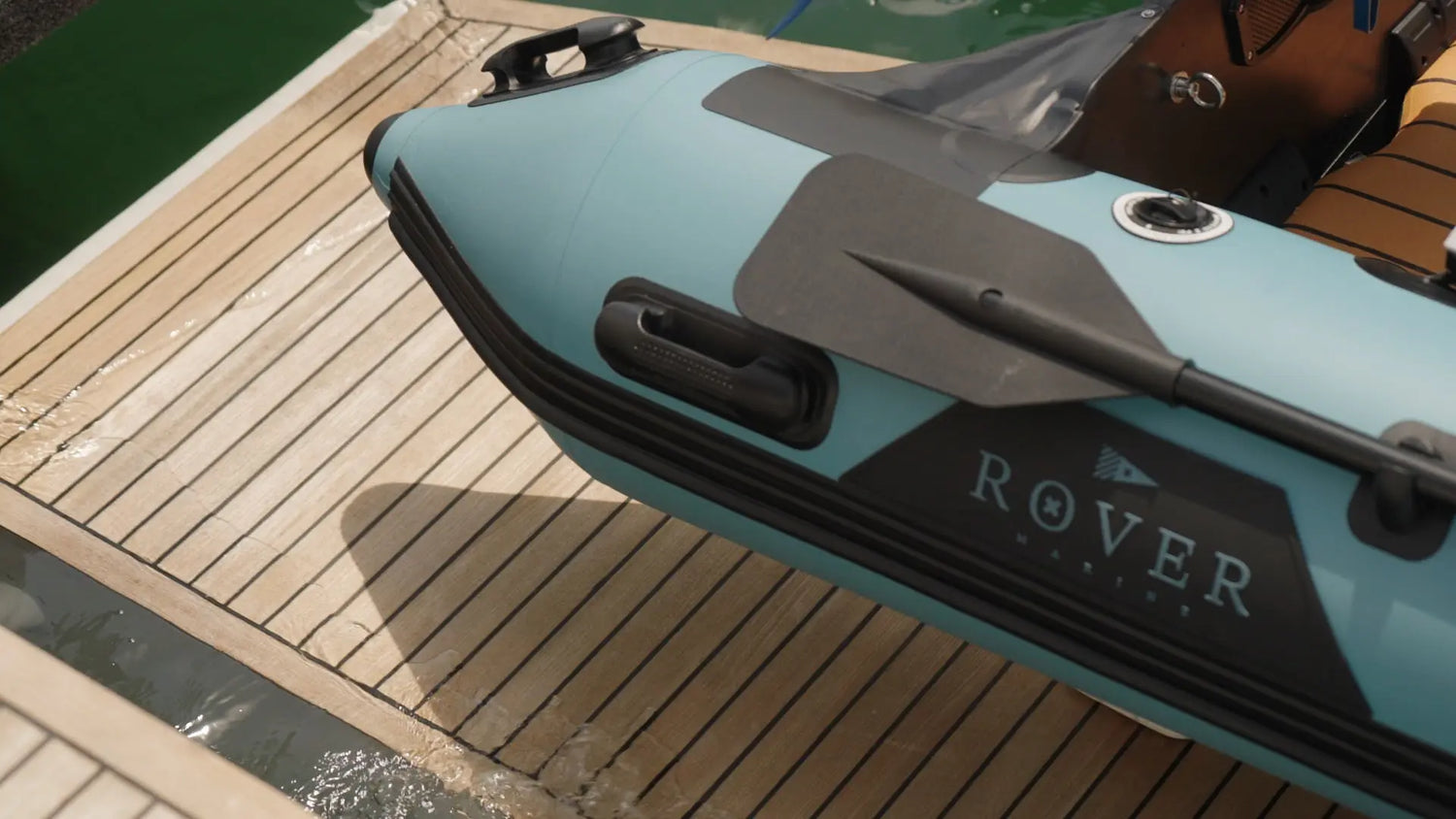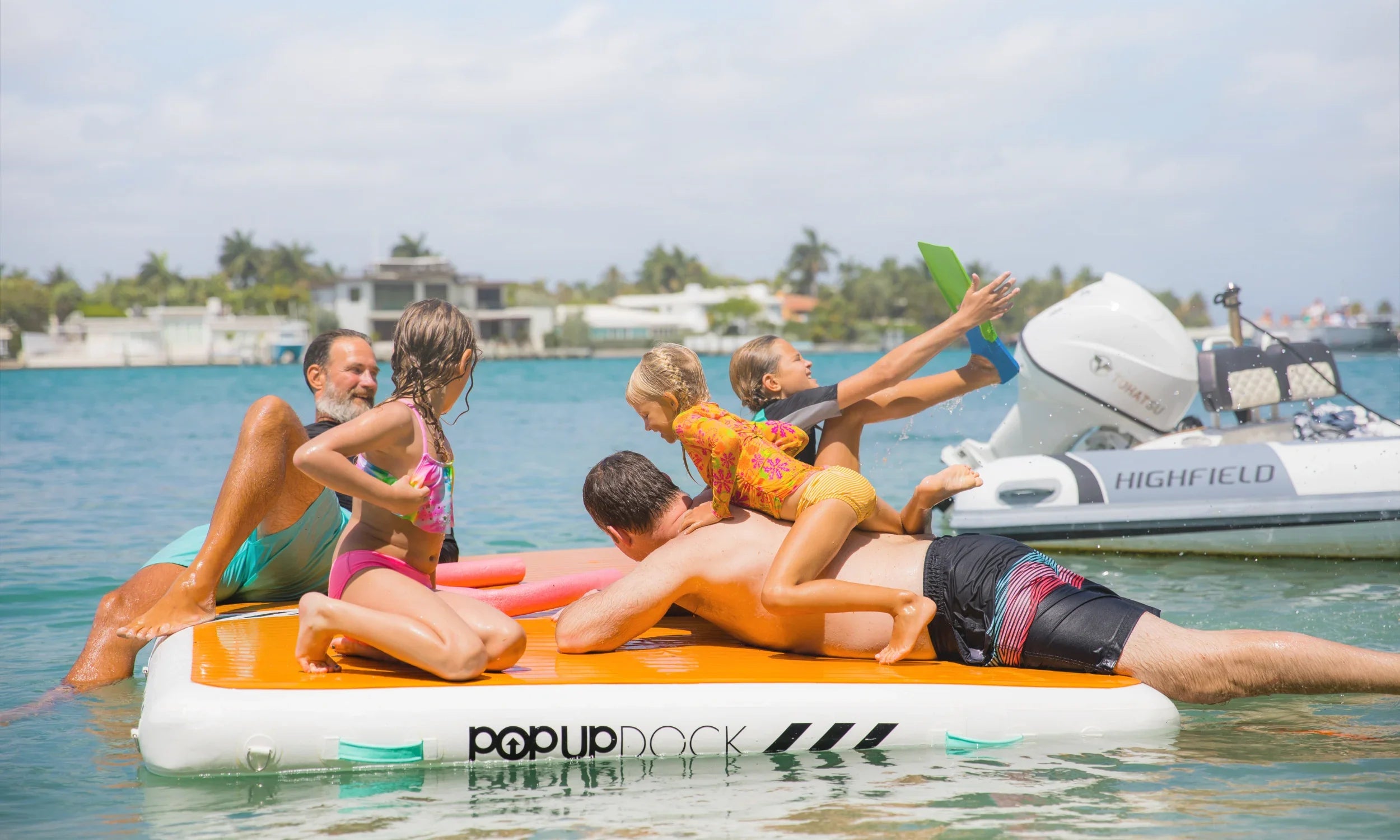Storing Your Inflatable Boat: The Ultimate Winter & Long-Term Guide
Properly stowing your inflatable boat keeps its materials in top shape, warding off sun damage, mold, and seam stress, so it’s primed for your next outing.
For outdoor enthusiasts who’ve invested in a dependable inflatable boat, clear, practical advice on prepping, cleaning, deflating, and safeguarding their inflatable boat for winter and extended periods is essential. This guide covers:
- Pre-storage prep: cleaning, gear checks, and folding methods.
- Winter storage tactics: ideal spots, inflation levels, and setup ideas.
- Long-term solutions: tough bags, space-saving tricks, and PVC-friendly care.
- Mold and sun defense: safe cleaners and cover recommendations.
- Post-storage upkeep: inspections, fixes, reinflation, and between-use tips.
- Why Canadian Board Co. boats, built with military-grade PVC and drop-stitch tech, are built tough, backed by a 60-day guarantee and expert support from Canadian Board Co.
By following these steps, you’ll protect your inflatable boat’s performance and lifespan, all while discovering top-tier gear and support from Canadian Board Co.
Getting Your Inflatable Boat Ready for Storage: The Best Approach
Preparing your inflatable boat for storage means a thorough clean, a careful check, and a gentle deflate. This combo stops material damage and packs it down tight for easy stowing. For instance, washing off salt and checking valves before folding cuts down on mold and seam leaks. These steps set the stage for the seasonal and long-term protection methods we’ll dive into.
How to Give Your Inflatable Boat a Good Clean Before Storing
Before you let the air out, cleaning your boat removes gunk that can lead to mold and break down the PVC. Grab a soft brush and a mild, non-gritty soap mixed with warm water to scrub the outside, paying extra attention to any folds or seams.
- Give it a good rinse with fresh water to wash away all the soap.
- Wipe it down with a cloth that won’t leave lint, making sure no dampness is hiding in the folds.
- Apply a UV protectant conditioner made for military-grade PVC to keep it supple.
Drying each section before you move on to checking the gear stops moisture issues and naturally leads into inspecting seams and valves.
What Gear Checks Should You Do Before Storing?
A pre-storage check-up confirms your boat is good to go and catches any problems early. Inspect the valves, seams, and the material itself like this:
- Valve Check: Inflate it a bit and listen for any hissing; swap out any faulty valves.
- Seam Check: Run a soapy water mix along the seams; any bubbles mean small leaks.
- Material Health: Look for scrapes, faded spots, or stiff patches on the PVC.
Sorting these out before deflating means fewer repairs down the line and smoothly transitions into proper folding techniques.
How to Deflate and Fold Your Inflatable Boat the Right Way
Deflating and folding it properly means it packs down small without creasing the PVC:
- Open all the valves and let the air out slowly.
- Gently press along the air chambers from the front to the back to push out any leftover air.
- Lay the boat flat on a clean spot and fold the side panels towards the middle.
- Start rolling it up from the front to the back, smoothing out any wrinkles as you go.
- Secure it with straps or tuck it into its special storage bag.
This rolling method puts minimal strain on the seams and gets the boat ready for winter and long-term storage routines.
How Should You Store Your Inflatable Boat for Winter?
Winter storage needs a steady environment that stops freezing damage and sun exposure while keeping the boat’s shape. Picking the right temperature, inflation level, and spot protects it from cold-weather stress and sets it up for long-term preservation.
What Are the Best Temperature and Environment Conditions for Winter Storage?
Keeping your storage spot between 10 °C and 20 °C in a dry, shaded area stops the PVC from shrinking and moisture from building up. Humidity below 60 % helps prevent mold, and good airflow stops condensation. A garage with climate control or an indoor rack fits these needs and gets your boat ready for the changing seasons.
Should You Store Your Inflatable Boat Inflated or Deflated in Winter?
Storing it slightly inflated at a low pressure can help keep its shape, but deflating it makes it much more compact.
Upsides of Slight Inflation:
- Keeps its form and reduces material creases.
- Makes it easy to check for leaks.
Upsides of Full Deflation:
- Saves a ton of storage space.
- Removes any risk of damage from freezing and expanding.
Your choice between these methods depends on how much space you have and your local winter temperatures, which will guide whether you go for indoor or outdoor setups.
What Are the Top Indoor and Outdoor Storage Solutions for Winter?
Choosing the right storage solution means combining protection and support to keep your boat’s structure and finish safe.
| Location | Protective Feature | Benefit |
|---|---|---|
| Climate-controlled garage | Steady temperature and humidity levels | Prevents PVC shrinkage and mold growth |
| Wall-mounted rack | Padded, adjustable hooks | Keeps the hull off the floor and maintains its shape |
| Covered outdoor shed | UV-resistant cover and elevated platform | Shields from sun and moisture |
Storing it inside on racks or in a covered shed with UV-resistant covers stops environmental damage and sets you up for long-term care methods.
What Are the Best Inflatable Boat Storage Solutions for Long-Term Care?
Long-term storage goes beyond just seasonal breaks; it requires solid protection from dust, pests, and material wear. Heavy-duty bags, smart folding, and UV-safe practices ensure your boat comes out looking its best after months off the water.
How to Use Heavy-Duty Storage Bags and Covers Effectively
Tucking your deflated boat into a tough, water-resistant bag keeps dust and pests out. Here’s how:
- Clean and dry the boat completely before putting it in the bag.
- Zip up or fasten all closures tightly to create a barrier against moisture.
- Store bags off the ground on pallets or shelves to allow air to circulate underneath.
Using heavy-duty covers protects your boat’s finish and leads into portable storage options that save space.
What Are Some Portable and Space-Saving Storage Options?
For garages or tight storage spots, think about collapsible racks or wall hooks paired with compact folding techniques.
| Storage Option | Description | Space Saved |
|---|---|---|
| Adjustable wall hooks | Mounts the boat flat against the wall | Up to 2 m² of floor space |
| Folding storage crate | Stackable plastic crate with a padded inside | Up to 1 m³ of volume |
| Rolling kayak dolly | Wheeled dolly with support straps | Frees up floor space |
These solutions keep your boat handy and pave the way for PVC care practices that boost material longevity.
How to Store Inflatable Boats to Prevent PVC Material Damage
Stopping PVC from losing its shape and getting damaged by UV rays involves these steps:
- Keep the boat in a cool, shaded spot, away from direct sun.
- Store it at the recommended inflation pressure or fully deflated, following the manufacturer’s advice.
- Rotate the stored boats now and then to even out any long-term pressure points.
These measures reduce stress on the PVC fibers and get the hull ready for mold and UV prevention techniques.
How Can You Keep Mold and UV Damage Away from Your Inflatable Boat During Storage?
Mold and UV rays speed up the wear and tear on inflatable boats. By using cleaning agents, UV-blocking covers, and regular checks, you can shield the hull from these threats. Effective control ensures your boat stays strong, flexible, and looking sharp.
Properties of Marine-Grade PVC and Strategies for Mold Prevention
Marine-grade PVC is engineered for durability, offering resistance to abrasion, mildew, bacteria, UV damage, and extreme temperatures. Proper storage involves thorough cleaning and drying to prevent mold and mildew growth. Maintaining good air circulation and storing the boat elevated off the ground further reduces the risk of moisture accumulation and pest damage.
This info backs up the tough nature of marine-grade PVC and offers proven ways to stop common storage problems like mold, fitting perfectly with the article’s advice on material care and prevention.
What Cleaning Products and Methods Help Keep Mold Away?
Using safe, mold-fighting agents when cleaning before storage keeps mold at bay:
- Rinse with fresh water to clear off any loose bits.
- Apply a solution of vinegar and water, mixed at a 1:4 ratio.
- Wipe down the surfaces with a soft brush and rinse again.
- Spray on a mold-inhibiting product made for PVC.
These steps kill off spores and get the surface ready for UV covers that maintain the next layer of protection.
How to Shield Your Inflatable Boat from UV Rays When Stored Outside
Covering your boat with a UV-resistant tarp or a custom storage cover bounces back harmful rays and stops heat from building up:
- Pick covers rated to block at least 95 % of UV rays.
- Secure them with straps or bungee cords so the wind can’t lift them.
- Make sure the covers don’t flap against the hull at the edges.
A stable, full-coverage setup blocks radiation and helps you spot any damage signs early.
What Signs of Mold or UV Damage Should You Look For?
Keep an eye out for these warning signs on your boat:
- Dark or greenish spots along the seams, indicating mold.
- Chalky or faded patches on the exposed PVC, showing UV damage.
- Stiff or cracked sections, suggesting the material is wearing out.
Dealing with these symptoms quickly through cleaning and protective measures keeps the hull in good shape and leads into post-storage maintenance steps.
What Maintenance Is Needed After Storing Your Inflatable Boat?
Getting back on the water after storage means inspecting, fixing, and reinflating correctly to ensure performance and safety. A step-by-step post-storage routine confirms the boat is ready and completes the care cycle that started before storage.
How to Inspect and Repair Your Inflatable Boat After Storage
Start with a thorough visual check and a pressure test:
- Inflate the boat to the recommended PSI and apply soapy water to all seams and valves.
- Mark any leaks and patch them up using a PVC repair kit and adhesive, following the instructions.
- Check accessories like oarlocks, drain plugs, and handles for any signs of wear.
Completing these tasks sets you up for smooth reinflation and on-water prep.
What Is the Best Way to Reinflate and Get Your Boat Ready for Use?
Reinflating it properly ensures it has the right shape and performs well:
- Use a calibrated hand or electric pump with a pressure gauge.
- Inflate the main chambers first, then top off the smaller ones to an even pressure.
- Check the air pressure after 10 minutes for any slow leaks.
- Secure all valves and fittings before you launch.
This controlled inflation phase gets the hull ready to glide smoothly on the water without any stress points.
How to Store Your Inflatable Boat Between Uses During the Season
Keeping your boat protected between weekend trips saves you the hassle of setting it up repeatedly:
- Deflate it slightly to make it easier to handle and fold loosely.
- Store it on padded racks or hanging straps indoors or under a UV-resistant cover.
- Rinse it with fresh water after each use to get rid of dirt and salt.
Seasonal interim storage keeps the boat in good condition and cycles back to pre-storage prep when needed.
Why Choose Canadian Board Co. Products for Tough Inflatable Boats?
Canadian Board Co. brings together military-grade PVC materials and drop-stitch construction to create inflatable boats that can handle tough Canadian weather, all backed by quick support and a 60-day rider’s guarantee. This dedication to quality and service makes every storage and maintenance cycle a breeze for outdoor adventurers.
How Do Military-Grade PVC and Drop-Stitch Technology Boost Storage Durability?
Military-grade PVC panels resist scrapes and UV rays, while drop-stitch cores keep their shape under pressure, leading to:
| Feature | Mechanism | Benefit |
|---|---|---|
| Military-grade PVC | High-tensile polymer layers | Withstands scratches and punctures |
| Drop-stitch core | Thousands of internal threads | Provides rigidity and prevents warping during storage |
| UV-resistant coating | Reflective polymer finish | Blocks harmful radiation |
The Impact of UV Radiation and Environmental Factors on Inflatable Boat Lifespan
Prolonged exposure to ultraviolet (UV) rays causes PVC degradation, making the material brittle and affecting adhesives, which can significantly shorten an inflatable boat's lifespan. High heat and humidity also stress the material, while sub-freezing temperatures can make PVC brittle and prone to cracking if folded. Storing boats in climate-controlled environments or using protective covers can mitigate these effects.
This research highlights how environmental factors like UV rays, extreme temperatures, and humidity directly affect the toughness and lifespan of inflatable boat materials, supporting the article’s advice on protective storage.
What Customer Support and Guarantees Does Canadian Board Co. Offer for Storage Worries?
- 60-day rider’s guarantee for returns or exchanges.
- Quick email and phone support for advice on storage and repairs.
- Free shipping across Canada on orders over £100.
This level of service builds confidence and guides you through any post-storage questions.
How Do Canadian Board Co. Products Inspire Canadian Outdoor Adventures?
By designing boats that pack down small and set up fast, Canadian Board Co. encourages:
- Weekend paddles on Okanagan Lake without needing bulky trailers.
- Family fun in hidden coves that require easy transport.
- Spontaneous trips down rivers and along coastlines thanks to quick inflation.
These experiences mean more time on the water and deeper connections with Canada’s great outdoors.
What Are Common FAQs About Inflatable Boat Storage?
Many boat owners wonder if a garage is good enough for winter storage, how often to clean during long-term storage, and if heat sources are a problem. Storing in a garage offers steady temperatures and dry conditions, making it ideal when boats are fully deflated and covered. Cleaning every three months stops mold from building up on stored PVC, and keeping boats away from heaters or fireplaces prevents heat-related warping. Understanding these tips clears up doubts and helps you keep your inflatable boat in top shape all year.
Proper inflatable boat storage involves preparation, seasonal adjustments, and tough materials to keep your watercraft safe. Following these tips ensures your boat is always ready for adventures on Canadian lakes and rivers. Investing in quality gear from Canadian Board Co. provides the reliability and support you need for every stage of storage, use, and exploration. By putting these strategies into practice, you’ll enjoy smoother launches, fewer repairs, and a longer-lasting boat without sacrificing performance.







Leave a comment
All comments are moderated before being published.
This site is protected by hCaptcha and the hCaptcha Privacy Policy and Terms of Service apply.